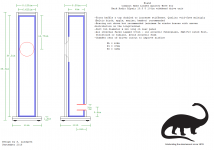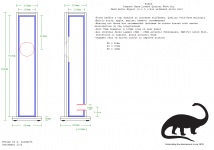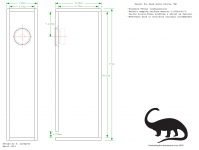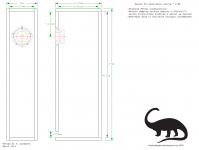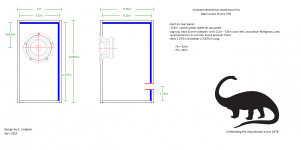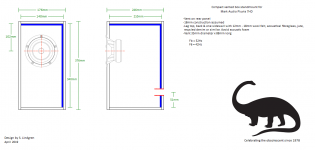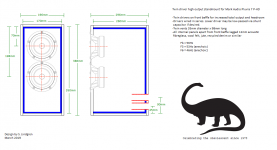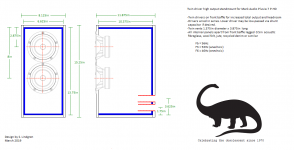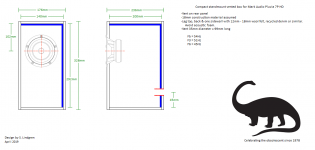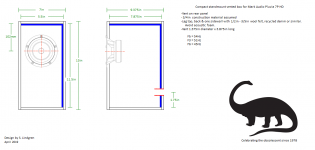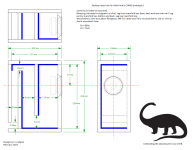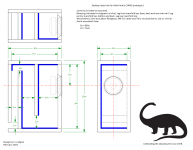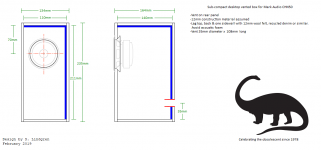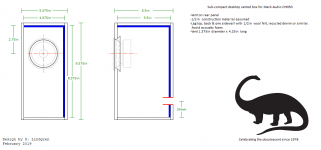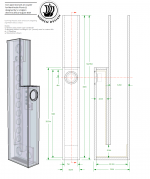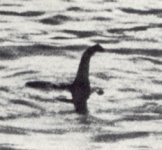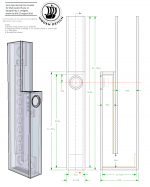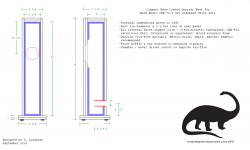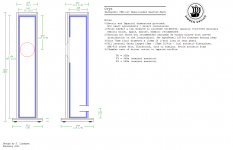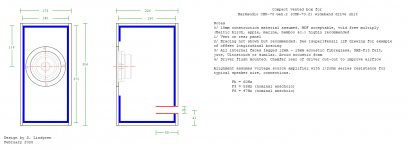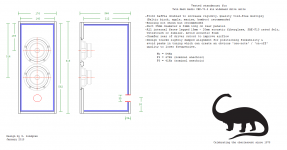Member
Joined 2009
Paid Member
wow, great thread, keep dumping stuff and we'll be asking for a sticky designation!
Back to my selfish question: can I put the new 7MS into this: MARTELLO-2, a mini-tower from a single 2' x 4'
as a potential upgrade to the EL-70 in terms of mid-high finesse etc. ?
Back to my selfish question: can I put the new 7MS into this: MARTELLO-2, a mini-tower from a single 2' x 4'
as a potential upgrade to the EL-70 in terms of mid-high finesse etc. ?
Replied on your thread so things are kept together & this thread stays to its intended purpose. Apologies for the brevity of the posts, but I haven't much internet access time left.
And for the Alpair 11MS.
Similar approach to the above; aims for a bit more extension than the pensil, without quite as much gain through the mid-upper bass, and with a more conventional impedance (again, not particularly reactive). Back to naming those poisons.
Following above, questions with the answer 'yes'
-Can I use MDF? (if you really, really must, but a quality multiply is strongly preferred)
-Can I use xyz wire or binding posts? (providing you don't raise series R by > 0.2ohm)
-Can I use acoustastuff, BAF etc. for the lagging?
-Can I omit the over-sized plinth? (providing you maintain a doubled baseplate)
-Can I tilt the enclosure to angle the driver to the desired axis?
Questions with the answer 'no'
-Can I omit the doubled top & front baffle?
-Can I move the driver?
-Can I move the vent?
-Do I have to use spikes?
Imperial & metric sketches attached. Poor quality, but I can't plague Dave constantly & they're not really rocket science.
With a few tweaks could this be used for the Alpair 10.3m?
I didn't want to put out any other boxes for the 10.3 / 10P as there are plenty of quality designs for these units already available. If you want a relatively compact ML quarter-wave variation though: attached.
Following the above, questions with the answer 'yes'
-Can I use the Alpair 10P? (F3 & F6 rise slightly but a decent alignment)
-Can I use MDF? (if you must, but a quality multiply is preferred)
-Can I use xyz wire or binding posts? (providing you don't raise series R by > 0.2ohm)
-Can I use acoustastuff, BAF etc. for the lagging?
-Can I omit the over-sized plinth? (providing you maintain a doubled baseplate)
-Can I tilt the enclosure to angle the driver to the desired axis?
Questions with the answer 'no'
-Can I use a different driver (including different generations of the Alpair 10)?
-Can I omit the doubled top & front baffle?
-Can I move the driver?
-Can I move the vent?
-Do I have to use spikes?
Following the above, questions with the answer 'yes'
-Can I use the Alpair 10P? (F3 & F6 rise slightly but a decent alignment)
-Can I use MDF? (if you must, but a quality multiply is preferred)
-Can I use xyz wire or binding posts? (providing you don't raise series R by > 0.2ohm)
-Can I use acoustastuff, BAF etc. for the lagging?
-Can I omit the over-sized plinth? (providing you maintain a doubled baseplate)
-Can I tilt the enclosure to angle the driver to the desired axis?
Questions with the answer 'no'
-Can I use a different driver (including different generations of the Alpair 10)?
-Can I omit the doubled top & front baffle?
-Can I move the driver?
-Can I move the vent?
-Do I have to use spikes?
Attachments
Last edited:
I'm a huge fan of the Mark Audio Alpair drivers. I daily use a 3-way design where the Alpair 10M gen 1 takes on a mid/bass driver role ie it is crossed to a tweeter proper. Actually two Seas tweets.
The bass duty is taken on by a Peerless HDS 8" poly-cone driver that is sadly no longer produced by the parent company Tymphany.
I was afraid that the Alpair would not produce enough bass so I put in a bass driver crossed at 250 herz.
The Alpair 10 can deliver bass even in a big enclosure but the level isn't there for the lowest octave.
My design is a 60 liter vented box. I don't do imperial so I couldn't say what it is in cubic inches.
I have a pair of 10P gen 1 that is out of work. So I'm trying to find a role for them. Maybe I construct a TQWT for them. I think that they would work wonderfully without a cross-over. 🙂
The bass duty is taken on by a Peerless HDS 8" poly-cone driver that is sadly no longer produced by the parent company Tymphany.
I was afraid that the Alpair would not produce enough bass so I put in a bass driver crossed at 250 herz.
The Alpair 10 can deliver bass even in a big enclosure but the level isn't there for the lowest octave.
My design is a 60 liter vented box. I don't do imperial so I couldn't say what it is in cubic inches.
I have a pair of 10P gen 1 that is out of work. So I'm trying to find a role for them. Maybe I construct a TQWT for them. I think that they would work wonderfully without a cross-over. 🙂
And here's a different one. This is for the 6in Sonido unit with the AlNiCo motor. Sonido get less coverage than they probably should here.
Nothing exciting; straightforward BR assuming an amplifier with a modest output impedance. Voltage source, it's a quasi-EBS. With something like a PP valve, single-ended SS or valve SET with a stiff power supply & an output impedance up to about 2.5ohms, should be quite nice. Doesn't get hyper-low, but not bad for a modest room or for those who want a standmount with a moderate footprint. Fairly compact, very stiff enclosure with the doubled panels.
Following the above, questions with the answer 'yes'
-Can I use MDF? (if you really, really must, but a quality multiply is strongly preferred)
-Can I use xyz wire or binding posts?
-Can I use acoustastuff, BAF etc. for the lagging?
-Can I put the vent on the front panel?
Questions with the answer 'no'
-Can I omit the doubled panels? (this was a bit of a design objective. If you really must, single thickness 25mm and hope I don't find out)
-Can I move the driver? (there is a little latitude here)
-Can I move the vent? (ditto)
Hi there Scott,
A friend of mine has a pair of these drivers stored somewhere. He sold his big horns when moving back into town. They were exceptionally balanced, as I recall. I must convince him to try your design.
If you've got any other ideas -of a reasonable size- please keep 'em coming. There's almost no alternatives for these great Hungarian drivers. They're priced to sell too and deserve to be better known out there.
Regards,
Vincula
Continuing my dumping ground for misc. designs I've come up with, here are pensils for the new Pluvia 7HD and Pluvia 7 P-HD. Like some of the above, these are new[ish] rather than old designs, but I haven't anywhere else to put them, so they can live here. Note that the HD and P-HD are very different drivers in design and balance, so try not to get them mixed up. 😉 Apologies as always for my rubbish sketches (some parts plundered from Dave's CAD drawings and adapted. Very badly).
The metal cone Pluvia 7HD is basically the guts of the Alpair 7.3 in a Pluvia basket with a couple of tweaks. The paper cone Pluvia 7 P-HD was created largely by the Japanese distributor & company co-owner with feedback from a specific set of his clients; the response caters for their particular requirements.
Shamelessly borrowing again from Troels Gravesen's text layout, :
Questions with the answer 'yes'
-Can I use MDF for construction? (if you must, but a quality multiply is preferred)
-Can I use xyz wire or binding posts? (providing you don't raise series R by > 0.2ohm)
-Can I use acoustastuff, BAF etc. for the lagging? (yes, but you will need to experiement with density. Since they're designed for this to be adjustable in the first place, you're bobbing)
-Can I add a plinth?
-Can I add bracing? (providing it doesn't distrupt the longitudinal standing wave)
-Can I tilt the enclosure to angle the driver to the desired axis?
Questions with the answer 'no'
-Are the Pluvia 7HD and Pluvia 7 P-HD interchangable, acoustically? (you can, but the alignment will shift away from the target)
-Can I move the driver?
-Can I move the vent?
-Do I have to use spikes?
The metal cone Pluvia 7HD is basically the guts of the Alpair 7.3 in a Pluvia basket with a couple of tweaks. The paper cone Pluvia 7 P-HD was created largely by the Japanese distributor & company co-owner with feedback from a specific set of his clients; the response caters for their particular requirements.
Shamelessly borrowing again from Troels Gravesen's text layout, :
Questions with the answer 'yes'
-Can I use MDF for construction? (if you must, but a quality multiply is preferred)
-Can I use xyz wire or binding posts? (providing you don't raise series R by > 0.2ohm)
-Can I use acoustastuff, BAF etc. for the lagging? (yes, but you will need to experiement with density. Since they're designed for this to be adjustable in the first place, you're bobbing)
-Can I add a plinth?
-Can I add bracing? (providing it doesn't distrupt the longitudinal standing wave)
-Can I tilt the enclosure to angle the driver to the desired axis?
Questions with the answer 'no'
-Are the Pluvia 7HD and Pluvia 7 P-HD interchangable, acoustically? (you can, but the alignment will shift away from the target)
-Can I move the driver?
-Can I move the vent?
-Do I have to use spikes?
Attachments
And while we're at it, a few more for the new units. Compact vented standmount for the Pluvia 7HD. Perfectly standard, meant for smaller spaces or at least where space is at a premium.
Attachments
Last edited:
And two for the paper cone version; single and twin-driver boxes.
Attachments
Blast. Forgot the ones for the CHN50.
Two compact vented desktop & a compact desktop labyrinth.
Two compact vented desktop & a compact desktop labyrinth.
Attachments
Continuing my dumping ground for misc. designs I've come up with, here are pensils for the new Pluvia 7HD and Pluvia 7 P-HD. Like some of the above, these are new[ish] rather than old designs, but I haven't anywhere else to put them, so they can live here. Note that the HD and P-HD are very different drivers in design and balance, so try not to get them mixed up. 😉 Apologies as always for my rubbish sketches (some parts plundered from Dave's CAD drawings and adapted. Very badly).
The metal cone Pluvia 7HD is basically the guts of the Alpair 7.3 in a Pluvia basket with a couple of tweaks. The paper cone Pluvia 7 P-HD was created largely by the Japanese distributor & company co-owner with feedback from a specific set of his clients; the response caters for their particular requirements.
Shamelessly borrowing again from Troels Gravesen's text layout, :
Questions with the answer 'yes'
-Can I use MDF for construction? (if you must, but a quality multiply is preferred)
-Can I use xyz wire or binding posts? (providing you don't raise series R by > 0.2ohm)
-Can I use acoustastuff, BAF etc. for the lagging? (yes, but you will need to experiement with density. Since they're designed for this to be adjustable in the first place, you're bobbing)
-Can I add a plinth?
-Can I add bracing? (providing it doesn't distrupt the longitudinal standing wave)
-Can I tilt the enclosure to angle the driver to the desired axis?
Questions with the answer 'no'
-Are the Pluvia 7HD and Pluvia 7 P-HD interchangable, acoustically? (you can, but the alignment will shift away from the target)
-Can I move the driver?
-Can I move the vent?
-Do I have to use spikes?
Hi Scott,
Could you please provide the F3, F6 for these enclosures.
Which is the successor to alpair 7.3 , is it pluvia 7hd or alpair 7ms?
Or is pluvia 7hd successor to pluvia 7?
alpair 7.3 and alpair 7ms are similarly priced, which is significantly more than pluvia 7hd price.
Last edited:
Hi Scott,
Could you please provide the F3, F6 for these enclosures.
F3 no (not important or meaningful to the human ear/brain, ref Toole). F6 estimated yes.
Which is the successor to alpair 7.3 , is it pluvia 7hd or alpair 7ms?
A7ms is the successor but P7HD is supposedly a direct evolution based on A7.3 soft parts.
dave
Lacking a rear spider/suspension, and with the very shallow / reverse curve profile, the MS models don’t really have any direct antecedents with the Mark Audio name on the labeling, and the new Pluvia series represent Mark’s efforts to both reduce amount of material in frame and simplify installation by eliminating the need for deep rebates. Of course the flip side of that is the need for even deeper chamfer on the rear side of driver opening - particularly on the smaller sizes.
With the current interest in Loch Ness and our resident survivor, it seemed time for a couple of Nessie enclosures. I haven't done one of these for years, but dug out my 'Nessie Alignment' spreadsheet I created a decade ago & fired it up.
Nessies do not look very pretty on a graph, like most big QW pipe variations, but those who like them really like them; they also look a bit different to the norm. The smaller driver versions need you to go easy on the volume knob as excursions are relatively high.
Note: the drawings credit Dave for the CAD work; actually I modified one of his existing drawings (all the bad bits are mine) as I can't plague him constantly, and it looks a bit better than my miserable 'from-scratch' efforts; he still should get the credit though.
Pluvia 11 Nessie:
Nessies do not look very pretty on a graph, like most big QW pipe variations, but those who like them really like them; they also look a bit different to the norm. The smaller driver versions need you to go easy on the volume knob as excursions are relatively high.
Note: the drawings credit Dave for the CAD work; actually I modified one of his existing drawings (all the bad bits are mine) as I can't plague him constantly, and it looks a bit better than my miserable 'from-scratch' efforts; he still should get the credit though.
Pluvia 11 Nessie:
Attachments
Since I'm currently selling a stash of brand-new-in-box CHP-70 Gen.2 (aka CHP70.2) drivers in the appropriate part of the forum, it occured to me to have a traul through some of my more accessible HDDs to see if I had any unpublished designs. I've found one at least, so adding here, for completeness. Looking it over, I see I missed a depth dimension for the plinth, which should be 10 3/4in. Fb as I recall is 47Hz, output to the low 40s. Flat anechoic alignment (I don't normally do that, but in this case it gives it a bit of a kick that suits the driver) & adjustable length spikes are suggested so you can tilt it back to aim at the listening position.
Attachments
I hadn't intended to do any more boxes for the CHP-70.2 (not for the time being anyway), but since I've sold some of my stash of NIB units and there aren't a vast number of designs out there for it, here's one I've run my own pair in. Nothing fancy, just a smallish vented box; I've played off the alignment to suit the driver's own character; lightly damped around tuning with a slight increase an octave above Fb due to the system Q. I've also found one I did a while back for two of the units; acoustically slightly larger volume & tuned a bit lower. One can be rolled off if / as desired, or both run wide open as the builder prefers.
Attachments
Last edited:
One can be rolled off if / as desired, or both run wide open as the builder prefers.
Here is the document that describes the possible connections to 2 x FR driver. Done originally for one of the precursors to the CHP70.2.
http://www.planet10-hifi.com/downloads/Dual-Driver-Wiring.pdf
dave
- Home
- Loudspeakers
- Full Range
- Miscellaneous designs - Markaudio, Fostex, TB, Dayton, SEAS etc
